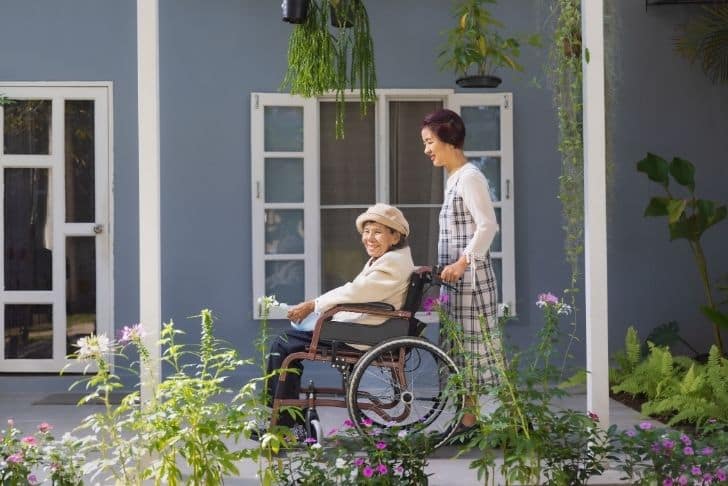You’re about to get familiarized with the concept of improving home safety with the help of mobility aids. This article is all about devices specifically designed to assist individuals having difficulties moving around. These aids are indeed a boon to people with disabilities, those recovering from injuries, and older adults at risk of falls, offering benefits such as increased independence and confidence. From conventional aids like canes, crutches, and walkers, to wheelchairs and mobility scooters, and even trained service animals like guide dogs, there’s a range of options to suit different needs.
Beyond the aids themselves, home adjustments such as ramps, stair lifts, and handrails can offer even more independence and safety. The use of these aids and modifications is invaluable for people with certain conditions, rejoicing in the newfound independence despite the potential risks and specifications associated with their use. Now, let’s explore this empowering world of mobility aids that’s making homes safer and lives better.

Understanding Mobility Aids
Definition of mobility aids
Mobility aids are specially designed devices aimed at enhancing the mobility of individuals who struggle with movement. They provide increased freedom and independence, allowing those using them to complete tasks and go places they might not otherwise be able to visit.
Who benefits from mobility aids
Mobility aids are a boon to several groups of individuals. People with disabilities, those recovering from injuries, and older adults who are at a high risk of falling can all significantly benefit from using these devices. Additionally, they can be helpful to individuals struggling with conditions like arthritis and cerebral palsy, as well as those recuperating from surgeries.
The benefits of using mobility aids
The use of mobility aids comes with several advantages. They enhance independence by allowing users to move about and perform their daily tasks without requiring constant assistance. Additionally, they can help alleviate pain by providing support and improving balance. Finally, they can greatly boost self-esteem and confidence by making users more self-reliant.
Types of Mobility Aids
Brief overview of different types of mobility aids
There are several different types of mobility aids, each uniquely designed to cater to different mobility challenges. These range from canes and crutches to more advanced devices like wheelchairs, mobility scooters, and guide dogs.
Canes
Canes are simple yet effective mobility aids. They provide support to the body’s weight and help with balancing but can place increased pressure on the user’s hands and wrists.
Crutches
Crutches are used to move the responsibilities of weight bearing from the legs to the upper body. They can be used either singularly or in pairs and are commonly used by individuals temporarily facing mobility issues, like broken legs.
Walkers or Zimmer frames
Walkers, also known as Zimmer frames, are mobility aids used for added stability and support. They consist of a metal framework with four steady legs, providing a solid support system.
Wheelchairs
Wheelchairs are commonly used by individuals who cannot put weight on their lower limbs or are unable to walk at all. They come in several varieties and can even be customized to cater to the specific needs of the user.
Mobility scooters
Mobility scooters bear similarities to wheelchairs, but their design deviates a bit, incorporating a seat set on three, four, or even five wheels. They are usually driven using handlebars or a steering wheel and are typically battery-powered.
Guide dogs
Guide dogs are specially trained service animals that are used to escort people who are blind or visually impaired. They help users navigate obstacles and can be of great help in improving mobility.
Proper Usage of Canes
Understanding the function and design of canes
Canes are designed to provide a steady support structure for individuals struggling with balance and weight-bearing tasks. They are lightweight and usually come with a handle and a rubber-capped bottom for increased grip.
Benefits and limitations of using a cane
Using a cane can significantly improve balance and reduce the risk of falls. Additionally, they can help spread the pressure exerted by your body, thus reducing strain on your legs. However, they do place more pressure on your hands and wrists, which can cause discomfort for some people.
Steps to properly use a cane
To use a cane properly, you should hold the cane on the side opposite to the leg that needs support. While walking, move the cane first for a short distance, then move the weaker leg forward to the level of the cane, and finally, step past them both with your stronger leg.
Navigating with Crutches
Understanding the function and design of crutches
Crutches are designed to transfer weight from your legs to your upper body. They come in different designs, but all of them involve using your arms to bear your weight when your legs can’t.
Benefits and limitations of using crutches
Crutches can help keep an injured foot or leg elevated while still allowing for mobility. They allow for faster mobility than many other aids. However, they can be difficult to use and require good upper body strength and balance.
Steps to properly use crutches
When using crutches, place the crutches under your arms while keeping your injured foot off the ground. Transfer your body weight onto the handles of the crutches and swing forward. Place the crutches down at a point where you would normally reach if you were stepping forward.

Utilizing Walkers or Zimmer Frames
Understanding the function and design of walkers
Walkers or Zimmer frames are designed to provide maximum stability. They are particularly beneficial for those who need support for balance rather than for weight-bearing.
Benefits and limitations of using walkers
Walkers provide a high level of stability and largely reduce fall risks. However, they are bulkier than canes or crutches and require more room to navigate.
Steps to properly use a walker
To use a walker, step inside the frame, lifting the walker and placing it a short distance in front of you. Then, holding onto the handles, step forward with one foot at a time into the frame, starting with your weaker leg.
Life with Wheelchairs
Understanding the function and design of wheelchairs
Wheelchairs are designed for individuals who are not able to walk or stand. Some wheelchairs are manually propelled by the user, others by an assistant, and others are motorized, requiring little physical exertion from the user.
Benefits and limitations of using wheelchairs
Wheelchairs can provide freedom and flexibility, particularly for individuals who cannot walk at all. However, they can be challenging to maneuver in tight spaces and often require modifications to the home and office.
Guidelines to properly use a wheelchair
A properly used wheelchair should have its footrest and armrest at comfortable heights, and the user’s back should be flush against the back of the chair. Avoid leaning, reaching out too far or standing on the wheels, as these may cause the chair to tip over.

Getting around with Mobility Scooters
Understanding the function and design of mobility scooters
Mobility scooters are similar to a wheelchair but are configured like a motor scooter. They are usually battery operated and have a seat that swivels to facilitate easy mounting and dismounting.
Benefits and limitations of using mobility scooters
Mobility scooters can greatly enhance independence and can be particularly useful in covering long distances. However, they are expensive and require more space for operation and storage than many other mobility aids.
Steps to properly operate a mobility scooter
To operate a mobility scooter, users must sit comfortably with hands on the handlebars. They must be thoroughly aware of the controls, including the brakes, throttle, and reverse switch. Users need to start slow, gradually getting used to navigating around obstacles.
Living with Guide Dogs
Understanding the function and role of guide dogs
Guide dogs are trained from childhood to help blind and visually impaired people navigate through daily life. They help prevent their handler from bumping into or stumbling over obstacles.
Benefits and potential challenges of having a guide dog
A guide dog not only offers mailability assistance but can also be a great companion, bringing immeasurable joy to their handler’s life. However, they require time and dedication, as the handler must actively engage in the dog’s training and ongoing care.
Training and care requirements for guide dogs
Guide dogs undergo rigorous professional training before they are paired with a handler. Once paired, the handler is taught commands, navigation cues, and how to take care of the guide dog. Regular exercise and a healthy diet are key to a guide dog’s care.
Home and Office Safety Modifications
Need for environmental modifications
Modifications to the home and office environment are typically required for easy maneuverability of mobility aids. Ensuring a safe and accessible environment greatly enhances the effectiveness of these aids.
Types of modifications like ramps, stair lifts, and handrails
Various modifications can be made based on the individual’s needs and the mobility aid used. This can include installing ramps at steps or entrances, adding stairlifts, and providing handrails, etc.
Considerations when modifying a home or office for mobility aid usage
When modifying an environment for mobility aids, consider the comfort and ease of the person using the aid. The modifications should be in line with the individual’s daily routine and should facilitate rather than hamper their movements.
Potential Risks and Precautions with Mobility Aids
Common risks associated with improper use of mobility aids
Improper use of mobility aids can lead to various risks like falls and injuries. It can also cause strain and overuse injuries. In severe cases, using crutches improperly can lead to nerve damage, also known as crutch paralysis.
Potential health conditions due to improper usage
Misuse of mobility aids such as holding it incorrectly, using the wrong type or size, and not keeping it well maintained can cause health problems like sores, blisters, bruises, nerve compression, poor posture, and even chronic pains.
Importance of seeking professional guidance on the use of mobility aids
It is highly recommended to seek professional guidance when starting to use a mobility aid. Physiotherapists or occupational therapists can provide valuable advice on the correct use of these devices based on one’s condition, weight, and height requirements.
General safety precautions while using mobility aids
Safety must be the priority while using mobility aids. Regular maintenance, usage of aids of the correct size, and maintaining a good posture can contribute to a safer and more comfortable experience. It is also critical to adapt your home and office spaces to prevent accidents.
